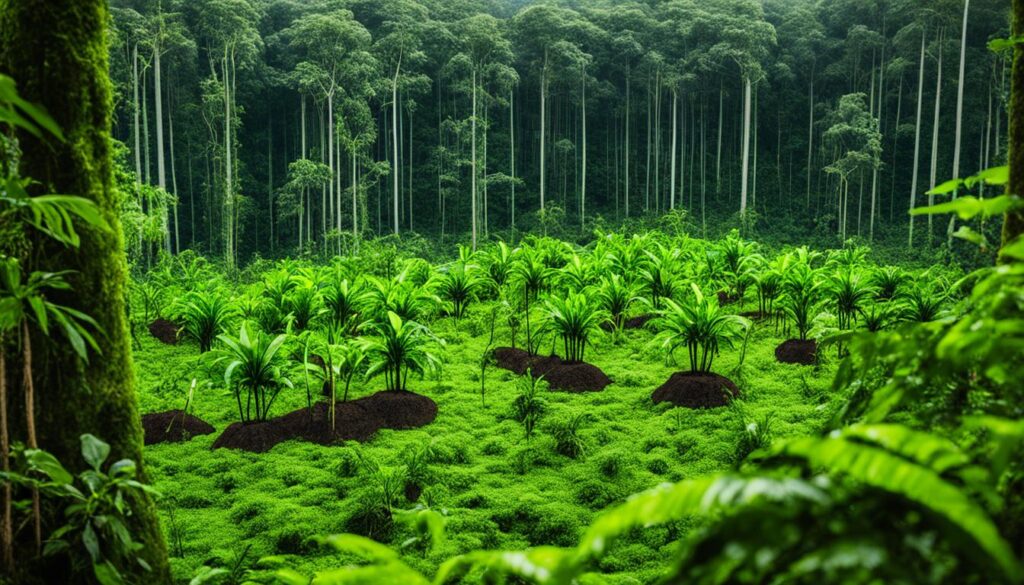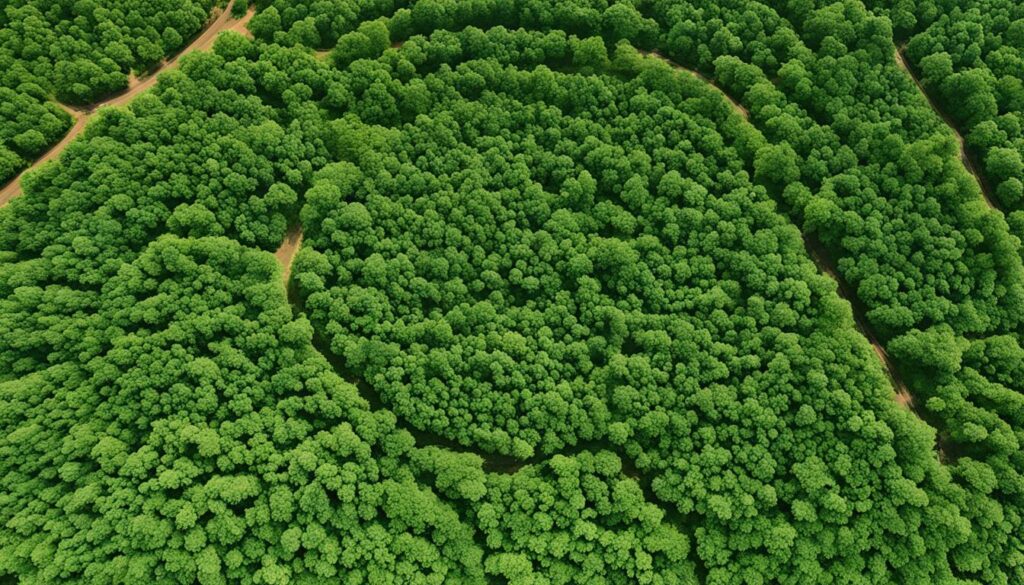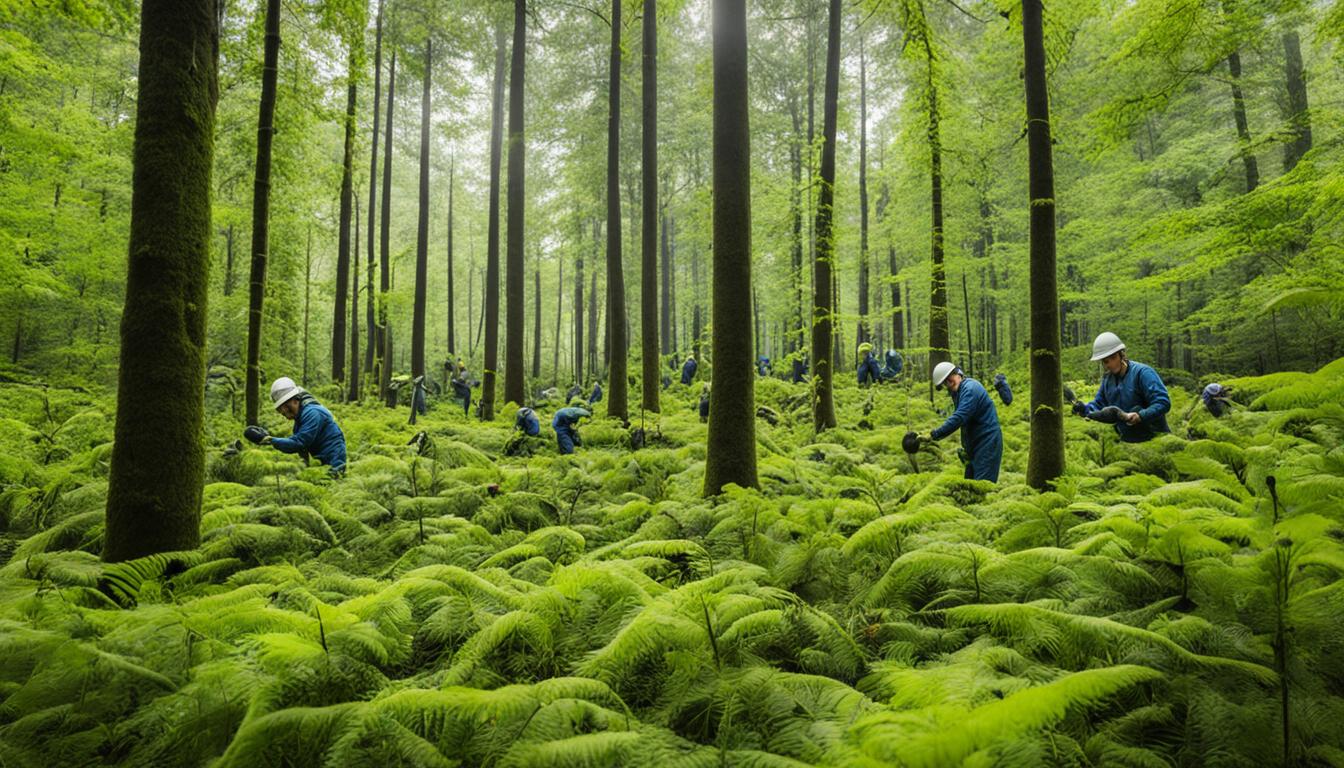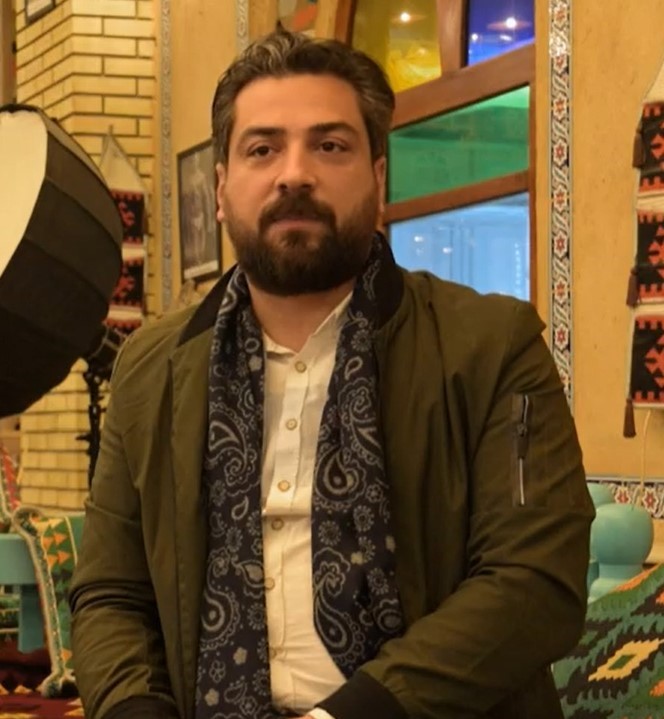A big plan to grow 73 million trees in the Brazilian1 Amazon has made great strides, even with some challenges. It started in 2017, focusing on the edges and the heart of the Amazon. These areas are key for keeping the forest alive.
This effort has two main parts. Amazonia Live is led by the Rock in Rio music festival and Conservation International. The Amazon Sustainable Landscape project brings together many groups, including the Brazilian government and the World Bank. They aim to meet Brazil’s goals under the Paris Agreement by reforesting 12 million hectares by 2030.
Key Takeaways
- A bold initiative to regrow 73 million trees in the Brazilian Amazon has made substantial progress.
- The initiative targets areas along the southern edges of the Amazon forest, known as Brazil’s “arc of deforestation,” and areas where natural regeneration is still possible.
- The initiative comprises two efforts: Amazonia Live and the Amazon Sustainable Landscape project.
- The goal is to help Brazil achieve its climate commitments under the Paris Agreement and its target of reforesting 12 million hectares of land by 2030.
- The project has faced challenges such as wildfires, deforestation, and the COVID-19 pandemic.
An Audacious Initiative to Regrow the Amazon
In 2017, a bold plan was set in motion to bring back the Brazilian Amazon rainforest by planting 73 million trees23. This huge project focuses on the “arc of deforestation” and the forest’s core, where trees can grow back naturally. It aims to help Brazil meet its climate goals and reforest 12 million hectares (nearly 30 million acres) by 203024.
Groups like Conservation International are leading this effort, and they’ve made great strides. They’ve already hit nearly 20 percent of their goal43. Their “muvuca” method, which uses a mix of native seeds, has been a success. It has produced three times more trees than expected4.
| Target | Progress | Exceeded Expectations |
|---|---|---|
| 73 million trees | Nearly 20% completed | 3 times more trees than estimated |
The project faces big challenges like wildfires, deforestation, and the COVID-19 pandemic. Yet, it keeps pushing to restore the Amazon and meet Brazil’s climate goals43. With a fresh plan and adjustments, they now expect to finish by 2026, two years later than planned4.
“This is an initiative that is truly audacious in its ambition, but one that is absolutely essential if we are to protect and restore the Amazon rainforest, which is critical for our global climate and biodiversity.” – [Source]
The Amazon Reforestation Initiative is a ray of hope for the Amazon’s future. It shows what we can achieve when we work together to fight deforestation and climate change243.
The Muvuca Seed-Planting Method
The muvuca method is a key part of the initiative. It’s promoted by the Instituto Socioambiental to cut down on costs5. Instead of planting trees one by one, it uses a mix of native seeds over a large area. This way, more tree types grow together6.
Spreading a Diverse Mix of Native Seeds for Higher Tree Yield
This method has shown great success, with trees growing three times faster than expected6. What was expected to be 3 million trees in 1,200 hectares is now 9.6 million trees. This could help make large-scale restoration more affordable6.
Initially, the goal was 2,500 trees per hectare. After ten years, it could reach 5,000 trees per hectare6. This method is not only more diverse and dense but also cheaper than traditional ways6.
| Metric | Traditional Reforestation | Muvuca Seed-Planting |
|---|---|---|
| Tree Yield | 3 million trees in 1,200 hectares | 9.6 million trees in 1,200 hectares |
| Trees per Hectare | 2,500 trees | 2,500-5,000 trees |
| Restoration Cost | Over $6 billion for 70 million hectares | More cost-effective than seedlings |
In Brazil, the Forestry Code requires 80 percent of the Amazon to stay forested5. The CAR helps enforce these rules and plans for restoration5. Planting a tree costs about US$4, and replanting 70 million hectares with seedlings could cost over US$6 billion. But the muvuca method is cheaper5.
For 20 years, Instituto Socioambiental has worked on Amazon restoration7. With partners, they’ve restored 11,000 hectares using the Muvuca method. This has led to about 33 million new trees and 80,000 tons of carbon dioxide saved each year7.
“The Redário, which supports seed collectors, involves 24 articulated seed networks and around 1,200 participants, trading more than 63 tons of seeds from 275 native species up to 2023. The Redário generated an income higher than 2.5 million Brazilian reais for seed collectors and supported the restoration of 11,000 hectares through Muvuca in over 95 projects in different Brazilian Biomes.”
The muvuca method is changing how we restore the Amazon rainforest. It’s more diverse, dense, and affordable than old ways6. By using many types of native seeds, it’s doing better than expected. This could lead to big restoration projects at lower costs567.
Challenges: Fires, Deforestation, and COVID-19
The Amazon reforestation project has faced big challenges like wildfires, deforestation, and the COVID-19 pandemic8. Despite its big goals, some restored areas have seen more forest fires and deforestation in protected parts of the Brazilian Amazon9.
Wildfires in the Brazilian Amazon have been severe, with more fires by September 2022 than in all of 20219. Deforestation in protected areas in Brazil has also gone up a lot in the last two years, which threatens the reforestation project’s success9.
The COVID-19 pandemic has hit the project hard. It affected planning, staffing, and transport, almost stopping the project for a long time10. But the team has still reached 20% of their goal, which is a big deal given the problems they faced8.
Restored Areas Affected by Wildfires and Deforestation
The Amazon rainforest, the biggest tropical forest, is facing more wildfires and deforestation9. These issues have hit the restored areas hard, setting back the reforestation project8.
Global Pandemic Halted Implementation for Long Periods
The COVID-19 pandemic has really slowed down the Amazon reforestation project10. It made planning, staffing, and transport tough, causing long pauses in the project10. Yet, the team has still reached 20% of their goal, showing their hard work and commitment8.
| Metric | Value |
|---|---|
| Global tree cover loss in tropical regions (2020) | ~12 million hectares10 |
| Deforestation alerts in the tropical world during initial COVID-19 lockdown (2020) | Almost twice the previous year10 |
| Increase in Amazon rainforest loss (up to March 2020) | 47% compared to 201810 |
| Increase in deforestation rate in Brazil (first trimester of 2020) | 55% compared to the same period in 201910 |
The Amazon reforestation project has faced big challenges like wildfires, deforestation, and the COVID-19 pandemic8. Despite these big problems, the team has stayed strong and keeps working towards their goals. This shows how important it is to restore the Amazon’s valuable ecosystem8910.
The Question of Permanence
Ensuring the long-term protection and monitoring of restored forests is key for the Amazon reforestation effort. In the tropical rainforest, trees grow fast, but it takes years for saplings to become mature trees11. However, the projects to restore forests often don’t last as long, making us wonder if they will stay.
To fix this, the initiative is taking steps. They plan to use long-term satellite monitoring to watch the restored forests and make sure they stay intact11. They are also working with local communities and governments to protect these areas better11.
Keeping restored forests safe is vital, as deforestation and forest damage are big threats in the Amazon12. Before, public policies helped reduce deforestation, but these efforts are now failing, and deforestation is going back up12. We need strong monitoring and community protection to keep the reforestation work going.
| Key Factors for Ensuring Permanence | Description |
|---|---|
| Satellite Monitoring | Ongoing remote sensing to track forest cover and detect any clearing or degradation |
| Community Engagement | Working with local communities to promote stewardship and on-the-ground protection |
| Government Partnerships | Collaborating with local and national authorities to strengthen environmental governance |
To make sure the restored forests last, we need a plan that uses technology, community efforts, and public support12. By tackling the main causes of deforestation, the initiative can make sure its work has a lasting effect13.
Early Optimism and Strategic Adjustments
Five years ago, the Amazon reforestation project was launched with high hopes. Now, despite a global pandemic and a shift in Brazil’s government, the team remains optimistic14. The project’s 2023 goal has moved to 2026 due to early hurdles. Yet, the team has learned to handle the project’s complex nature14.
The team now aims for a more strategic plan. They’re working with governments on project optimization, partnerships, public policies, natural regeneration, and restoration liabilities14. They see chances to grow the project by using the forest code and natural regeneration in protected areas14.
The COVID-19 pandemic slowed the project down, but the team is still aiming high15. They believe the new Brazilian government will keep valuing the environment and supporting the project14. With a new plan and strategy, the project is ready to make big changes in the next few years. It aims to help bring back the Amazon rainforest.
The Amazon reforestation project has faced many hurdles, but the team’s resolve and flexibility have kept it moving forward. By working with current public policies and trying new methods, like natural regeneration and using restoration liabilities, the project is set for success. It’s tackling environmental and social challenges head-on.
The Peugeot-ONF Forest Carbon Sink Project
In Brazil’s “arc of deforestation” in northwestern Mato Grosso state, the Peugeot-ONF Forest Carbon Sink project shines. It’s been working on ecological restoration and carbon sequestration for over 20 years16.
Started in 1999, this project has reforested 2,000 hectares (4,943 acres) of land. It has saved 394,400 metric tons of CO2, which is like taking 85,000 cars off the road for a year16. The project aims to last until 2039, using a method called Assisted Natural Regeneration (ANR). It planted 150 hectares (618 acres) with teak trees16.
There are over 400 permanent plots with around 40,000 trees. These are checked for biomass and carbon sequestration16. An independent check is happening now to make sure the project is doing well and will keep going16.
The project’s carbon credits are sold on the voluntary market through Pachama. This makes it a big part of the global effort to fight climate change1617.,
“This project is a prime example of how ecological restoration can not only revive degraded landscapes but also capture and store significant amounts of atmospheric carbon, providing a nature-based solution to the climate crisis.”

Big investors like Bain Capital Partnership Strategies, Byers Capital, and Union Square Ventures have put over $100 million into the Mombak project in the Amazon17.
The Peugeot-ONF Forest Carbon Sink project is a model for how to fight climate change. It shows how ecological restoration, carbon sequestration, and the voluntary carbon market can work together for real change171816.,
Ecological Restoration and Biodiversity Return
A 20-year effort to reforest 2,000 hectares at São Nicolau Farm has helped wildlife in the Brazilian Amazon19. This is a big deal because reforesting large areas in the Brazilian Amazon is rare and needs careful planning19. The goal is to balance climate solutions with saving biodiversity, making sure to capture carbon and restore habitats19.
Reestablishment of Pollinators, Mammals, and Increased Biodiversity
Studies show that pollinators like bees and wasps, and big mammals like monkeys and jaguars, are coming back19. In just 10 years, the reforested area has become more like the original forest than a degraded pasture19. This shows how well the project is working.
Experts say we need to plan restoration on a large scale for the best results in protecting biodiversity and water19. By planting certain trees, controlling weeds, and stopping fires, we can help nature heal faster19.
For very degraded lands, restoring them can also help the economy and stop the cycle of boom and bust19. Agroforestry is a new way to restore land, mixing farming with forest growth for a better future19.
“Restoration of forests can reduce global CO2 emissions by up to one third.”20
| Metric | Value |
|---|---|
| Deforested Amazon | Approximately 17% |
| Degraded Amazon | Another 17% |
| Restoration Potential | 80% of pre-degraded state in 20 years |
There’s a big chance to restore large areas cheaply in public forests, protected areas, and Indigenous lands that have gotten worse recently19. If we stop deforestation, reforest 50 million hectares, and restore 200 million more hectares, we could cut emissions by 60% in Latin America and the Caribbean by 2050211920.
amazon reforestation Carbon Sequestration and Trading
The Amazon rainforest covers about 6.7 million square kilometers across nine countries. It’s key to global carbon sequestration22. Yet, deforestation has led to the loss of a fifth of this vast area22. To fight this, projects like the Peugeot-ONF Forest Carbon Sink have started. It’s been approved by Verra, a top carbon offset certifier.
Verra Certification for Voluntary Carbon Market
The Peugeot-ONF project got Verra’s validation in 2011, making it trade carbon credits on the voluntary market22. It tracks the carbon in planted trees using Verra’s standards and the UNFCCC. With over 400 plots and 40,000 trees counted, it’s in its third check-up. An independent group will do the review, approved by Verra.
The voluntary carbon market is booming, with a 437% jump in carbon dioxide removal purchases in the first half of 202323. This shows more people want nature-based solutions to fight greenhouse gas emissions.
| Project | Carbon Sequestration | Carbon Credit Price |
|---|---|---|
| Peugeot-ONF Forest Carbon Sink | 394,400 metric tons of CO2 | Verra certified for voluntary market |
| Mombak’s Amazon Reforestation | 3 million trees planted | Over $50 per credit |
Mombak is a big name in carbon removal, selling credits for over $50 each23. They plan to spend $1 billion in the next 3 to 5 years on Amazon reforestation. This makes them a leader in the growing carbon market.
Combining carbon sequestration and trading with Amazon reforestation can help fund restoration and conservation22. But, more groups with short-term goals are joining the effort. This could slow down progress in stopping deforestation and protecting biodiversity22.
“Carbon credits play a significant role in the International Forest Governance (IFG) system, aiming to incentivize reforestation efforts and carbon trading, though they pose challenges and concerns of abuse.”22
As demand for carbon credits grows, we must make sure the process is clear, fair, and helps protect the Amazon rainforest for the long term.
Brazil Nut Corridor Project
In the Amazon’s heart, a new project is starting to make sure Brazil nuts can be harvested sustainably. The Brazil Nut Corridor project covers over 1 million hectares of mature rainforest in southeastern Peru. This area is mostly filled with the famous Brazil nut tree24.
Local Brazil nut concessionaires, often from the original settlers’ families, are working on this project. They manage concessions of 500 to 2,000 hectares in size24. The project teaches them how to care for young trees. This way, the Brazil nut forests will last longer, helping the local economy and the environment24.
This project does more than just help with Brazil nut harvesting. It also helps protect biodiversity. The corridor connects big protected areas in southeastern Peru, like Manu National Park and Tambopata National Reserve. This protects the area’s rich variety of life24.
“Brazil nuts are the only economically scalable yet sustainable non-timber forest product in the Amazon and the world’s tropics.”24
The Brazil Nut Corridor is very important. Because of logging, some species like Spanish cedar and big-leaf mahogany have disappeared. This project offers a way to make money without harming the environment. It helps local communities and protects the Amazon’s biodiversity24.

This project ensures the future of Brazil nut harvesting and protects a vital ecological link. Peru, the biggest producer of Brazil nuts, is fully supporting this effort. It shows the region’s commitment to keeping its natural beauty24.
Restoration at Finca Las Piedras
In the Amazon rainforest, Finca Las Piedras leads a key restoration effort. They focus on planting endangered species and making wildlife corridors. These corridors help reconnect forests that were once broken25.
The project at Finca Las Piedras shows how conservation can truly make a difference. By bringing back trees like Spanish cedar, big-leaf mahogany, and ironwood, they protect these endangered trees. They also help create a diverse and healthy ecosystem25.
But it’s not just about planting trees. The team at Finca Las Piedras also works on making wildlife corridors. These corridors let plants and animals move freely. This is key for the rainforest’s long-term health and strength25.
This restoration work does more than help the local area. The forests at Finca Las Piedras store a lot of carbon. This helps fight climate change25.
“Restoring the Amazon rainforest is not just about preserving a unique ecosystem – it’s about safeguarding the future of our planet. The team at Finca Las Piedras is leading the way in this critical endeavor.”
The Finca Las Piedras project shows the strength of working together on conservation. With the help of local communities and the latest science, they’re setting a standard for sustainable rainforest restoration. This can be a model for the Amazon basin26.
As we face climate change and lose biodiversity, Finca Las Piedras gives us hope. By planting endangered species, making wildlife corridors, and storing carbon, they’re not just restoring the rainforest. They’re also ensuring a better future for all of us272526.
Experimental Agroforestry
In the Amazon rainforest, researchers at Finca Las Piedras are testing new agroforestry methods. These methods are better than old farming ways. They help make the soil fertile again and bring back life to the area28.
Cacao-Brazil Nut Agroforestry System
They’re trying out a system that grows cacao and Brazil nut trees together. This way, farmers make money from cacao right away and can also get Brazil nuts later28. This method uses fewer chemicals, makes the soil better, and helps many different kinds of life29.
Inga-Copoazu Agroforestry System
At Finca Las Piedras, they’re also testing a system with Inga trees and copoazu, a cacao relative. This mix helps farming in a green way and brings back bees and other animals. It helps make the Amazon’s life rich again29.
These new farming ways copy the natural balance of the forest. They’re a better choice than just growing one crop29. With the Amazon losing land fast30, these methods offer hope. They show how farming and protecting nature can work together in the rainforest28.
“Agroforestry systems in the Amazon region typically include up to 4 dozens of different plant species on ¼ of a hectare, showcasing a high level of biodiversity within a small area.”29
The world needs sustainable farming fast. The work at Finca Las Piedras shows how farming and nature can live together. This could lead to a stronger and healthier Amazon28.
Conclusion
The efforts to restore the amazon reforestation have seen big steps forward, despite hurdles like wildfires, deforestation, and the COVID-19 pandemic31. New methods like the muvuca seed-planting and agroforestry systems are showing good results. They help with carbon sequestration, biodiversity conservation, and give local communities sustainable ways to live313233.
Keeping the restored forests safe and watched over is key, but the project’s early success and smart changes give hope for the Amazon’s future3132. With global teamwork, working with forest communities, and stopping deforestation, we can meet the goals of forest restoration and climate change mitigation. This will help with the sustainable development of the area313233.
As we face the big challenges of saving the environment and fighting climate change, the Amazon reforestation projects teach us a lot. They show how working together and using new ideas can help protect our natural world313233.
FAQ
What is the ambitious initiative to regrow trees in the Brazilian Amazon?
What is the “muvuca” seed-planting method used in the initiative?
What are some of the challenges faced by the reforestation initiative?
How are the organizers addressing the issue of ensuring the permanence of the restored forests?
What are some of the successful reforestation projects in the Brazilian Amazon?
How are the reforestation efforts contributing to carbon sequestration and the voluntary carbon market?
What are the benefits of the experimental agroforestry systems being tested in the Amazon?
Source Links
- Reforesting the Amazon
- ‘Audacious’ reforestation effort grows in Brazil
- 3 reasons for hope for the Amazon – Africa Biodiversity Collaborative Group (ABCG)
- World’s ‘largest’ tropical reforestation project slowed by Covid, Bolsonaro, fires
- How Brazil can restore an area twice the size of Germany
- Brazil Begins Effort to Plant 73 Million Trees in the Amazon
- Seeds of Change: Embracing the ‘Muvuca’ Method for Biodiversity and Social Restoration
- Afforestation, reforestation and new challenges from COVID-19: Thirty-three recommendations to support civil society organizations (CSOs)
- How the pandemic impacted rainforests in 2020: a year in review
- Frontiers | COVID-19, deforestation, and green economy
- Public Policies for the Protection of the Amazon Forest: What Works and How to Improve – CPI
- 25 photos of Amazon’s sustainability efforts around the world
- Renewable Energy and Community Resilience in Amazonia – Amazon Conservation Team
- Successes and struggles: Brazil’s 20-year Amazon reforestation carbon sink project
- Carbon Removal Startup Mombak Launches $100M Reforestation Project
- Peugeot and the ONF announce the launch of the sale of carbon credits
- From deforestation to restoration: Policy plots path to Amazon recovery
- Ecological Restoration: Transforming the Planet One Forest at a Time
- Restoring the Peruvian Amazon, One of the Most Ecologically Valuable Forests in the World
- Balancing Carbon and Cattle in the Amazon | Climatebase
- Carbon Removal Startup Hits $100M Fund to Save Amazon Forest
- Alliance for a Sustainale Amazon | Reforestation
- Alliance for a Sustainable Amazon | Rainforest Conservation in Peru
- Amazon Forest Ranger for Conservation Programme, Peru
- Partners – Analog Forestry
- Amazon Announces Investment in Nature-Based Carbon Removal Solutions in Brazil with The Nature Conservancy
- Agroforestry to preserve the Amazon rainforest – Ishpingo
- Amazon pledges support to forests and communities in the Brazilian Amazon
- Should we reforest the Amazon?
- Brazil scientists map forest regrowth keeping Amazon from collapse: Study
- Amazon Rainforest Facts & Stats 2020 (Why Reforestation Counts) | Rainforest Bowls & Stats 2020

